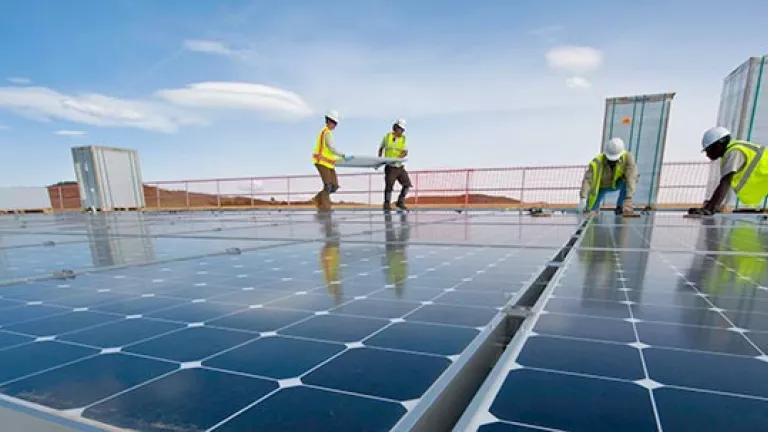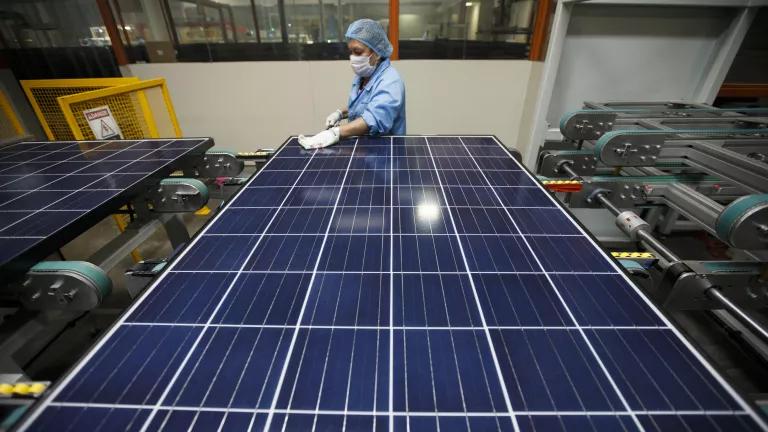House Panel Advances Clean Energy Funding
A House panel has advanced a Department of Energy budget bill that rejects President Trump’s dangerous proposals to hamstring the agency. Instead, the measure supports DOE’s clean energy innovation programs and injects significant new funding for clean energy deployment to aid in the nation’s economic recovery. We hope the Senate will quickly follow suit.

NREL
A House panel has advanced a Department of Energy budget bill that rejects President Trump’s dangerous proposals to hamstring the agency. Instead, the measure supports DOE’s clean energy innovation programs and injects significant new funding for clean energy deployment to aid in the nation’s economic recovery. We hope the Senate will quickly follow suit.
The bill approved by the House Committee on Appropriations last week provides $23 billion to DOE for emergency funding to drive economic recovery. This section includes programs that, if funded, would accelerate clean energy growth and create jobs and is an important recognition of the urgent need for green stimulus measures. In addition to making stimulus investments, the bill also provides steady funding to DOE’s clean energy programs through the regular appropriations process.
The House will likely move this bill forward next week, and then it’s up to the Senate to follow suit with strong support for clean energy innovation and deployment.
We hope to see lawmakers build on these provisions toward a comprehensive clean energy recovery plan with levels of federal investment to match the scale of the economic crisis gripping America.
Building Back Better with Clean Energy
The nation is dealing with staggering public health and economic effects from the coronavirus pandemic. The pandemic has also left tens of millions of Americans unemployed, laying bare the inadequacy of our social safety nets. This crisis has built on existing structural problems in the United States, ravaging the health of communities that have breathed dirty air from polluting industries for far too long. Moreover, the economic crisis has disproportionately hurt workers of color, who are more prevalent both in industries that faced high rates of layoffs and furloughs and in essential jobs that carry higher risk. And the crisis is far from over. New cases are rising, unemployment persists, and, as federal relief ends and eviction moratoriums end, 25 million people could be kicked out of their homes in the coming months. Congress must act now to provide additional relief, including rental assistance and a national eviction moratorium.
Long term recovery from the pandemic—and mitigation of future crises, including those caused by the climate emergency—will also require the nation to address these structural issues and build diversified, pollution-free economies that address historical pollution burden; center frontline communities, communities of color, and low-income people; and are powered by workers in high-quality jobs. Clean energy investments are one crucial part of a green recovery.
The House bill that moved last week includes almost $12 billion in funding for DOE’s clean energy demonstration and deployment programs to help people across the country build back better. These programs, which the president has proposed to cut or eliminate, accelerate upgrades to the nation’s building, electricity, and transportation infrastructure, creating jobs in the process. Making the needed improvements to our infrastructure requires an expanded workforce—hundreds of thousands to millions more people working on building out the clean energy economy. In fact, a recent E2 analysis estimated that about $100 billion in funding for programs like those in this bill would lead to more than 850,000 new jobs for the next five years.
Here are some highlights of the emergency funding section.
- Energy efficiency and solar for under-resourced communities: The bill includes $3 billion for the Weatherization Assistance Program (WAP), which provides services to seal and insulate homes for low-income households. WAP is one of DOE’s only programs focused on addressing inequities in building efficiency, yet it only reaches 0.1 percent of eligible participants per year with current funding levels. Funding for WAP will create jobs and save people money on their energy bills at a time when they need it most. The bill also provides $200 million to deploy solar energy in low-income communities.
- Funding for states and cities to advance clean energy: The bill includes $730 million for the State Energy Program, which provides funding for state governments to implement their energy conservation and clean energy goals, and $2 billion for the Energy Efficiency and Conservation Block Grant program, which provides funding to state and local governments for clean energy.
- Grid modernization and electrification infrastructure: The bill provides $1 billion for grants to deploy charging infrastructure to support electric vehicles and $2 billion to support grid modernization.
- Support for domestic manufacturing of clean energy: The bill includes $500 million to support manufacturing of clean energy and energy efficiency technologies and $770 million for domestic manufacturing of battery storage technologies.
- Demonstrations of newer clean energy technologies at scale: The bill includes $500 million for energy storage technology demonstration projects and $250 million for the Advanced Research Projects Agency–Energy (ARPA-E) to support demonstration projects.
There’s a lot of good in the emergency funding section of the bill. Yet, we need even greater levels of clean energy investment to recover from this crisis. And we need strong protections and carve outs to ensure that these programs prioritize projects that cut pollution in frontline communities, engage communities in the grantmaking and program design process, and create high quality jobs in places that are facing the greatest economic hardship.
Congress must build on this effort and direct every tool it has—from appropriations for existing programs to new authorizations to support for workers and more—toward economic relief and recovery.
Continued Support for Clean Energy Innovation
The House legislation also preserves DOE’s clean energy innovation budget for Fiscal Year 2021 and rejects the president’s dangerous proposal to cut funding for energy efficiency and renewable energy by 75 percent and eliminate key programs like WAP and ARPA-E. It instead includes steady funding for clean energy innovation (not including the large increases in funding for economic recovery, described above) and some helpful directives for the programs. Here are a few highlights:
- Steady Funding: The bill provides $2.8 billion for the Office of Energy Efficiency and Renewable Energy (equal to FY20 funding), $195 million for the Office of Electricity (3 percent increase), and $435 million for ARPA-E (2 percent increase), which help advance clean energy and grid modernization technologies.
- Workforce Development: The bill emphasizes the need for strong workforce development programs throughout DOE. Expansion of these programs is important to build out the clean energy workforce and create the millions of jobs we need to address climate change.
- Emissions Reductions: The bill includes a requirement for DOE to assess the emissions and environmental impacts of the projects it funds and to only fund projects that demonstrate reductions. We hope to see lawmakers build on this provision toward a rigorous climate and environmental screen to ensure that DOE investments go only to projects that contribute to deep decarbonization and minimize environmental impacts.
- Equity: The bill emphasizes the importance of DOE’s work to increase clean energy adoption among “low-income households, renters, multi-family homes, and racially diverse communities” and directs the agency to continue this work. This is an important direction, even if it is the tip of the iceberg of what DOE should be doing to help build an equitable clean energy economy.
- Agency Staffing: The House panel also reiterated the importance of maintaining a fully staffed agency. As we testified in February, DOE’s clean energy programs are severely understaffed, due to a failure by agency leadership to replace staff that have left.
A Mixed Bag on Nuclear Fuel and Waste
While our focus here is on the clean energy stimulus and innovation efforts, the DOE appropriations bill also addresses the agency’s work on nuclear fuels and waste—and unfortunately provides new support for fuel and reactor technologies that raise safety and proliferation concerns.
Even so, this section also does some good. It rightly rejects the Trump administration’s proposal to establish a uranium reserve. There is no sound justification for a uranium reserve, and we are glad to see the committee provided no funds for this purpose.
The bill also directs DOE to move forward to identify an interim storage facility for nuclear waste and instead use a consent-based approach, which is where communities agree to accept the waste before a site is chosen. The committee’s support for a consent-based approach is warranted and encouraging, but this support comes within a broken system that’s not designed to get consent before picking a site as opposed to as an afterthought. We hope that other committees charged with managing our nation’s nuclear waste will fix the system by revising the 1954 Atomic Energy Act accordingly, which my colleagues have long argued is necessary for a sound solution to nuclear waste. We were happy to see the House Select Committee on the Climate Crisis recommend the creation of a Task Force to study consent-based approaches and provide legislative recommendations to Congress.
What’s next?
Lawmakers should move the appropriations process forward to fund the government and provide green stimulus investments that the nation so desperately needs. We hope to see Congress build on the investments laid out in this bill with a larger stimulus package to drive an equitable green recovery from the ongoing economic crisis.


